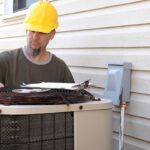What is a USDA loan?
USDA mortgages are a type of government-supported mortgage that can be used by low- and middle-income borrowers who purchase in certain rural areas. Also known as rural development or RD loans, it is part of a national program created by the US Department of Agriculture. Although often used by first-time home buyers, USDA loans are available to qualified borrowers who meet the eligibility requirements for income and property.
Who qualifies for a USDA loan?
To qualify for a USDA loan, you must:
- Become a US citizen or permanent resident
- Purchase in a rural area designated by USDA
- Occupy your home as your main residence
- Meet your income requirements based on the type of USDA loan you are applying for
Target properties
The easiest way to find out if your home is in a USDA eligible area is to check the USDA website. Homes purchased with USDA loans must be placed in eligible rural areas.
Income limit
The USDA loan program is aimed at low- and middle-income home buyers. Applicants must meet different income restrictions depending on family size, metro area and loan program. In more expensive areas, income caps are high. You may be able to earn as many as six people. You can use the same property qualifying tool on the USDA website to see income limits for counties and household sizes.
To prove your income, you must provide the following documents to your lender:
- PayStubs
- Tax Statements (W-2, 1040s and 1099s)
- Other evidence of income, such as alimony, child support payments, and social security benefits.
- Bank and Investment Account Statement
Credit score
Although the USDA does not impose blanket credit score requirements on all borrowers, USDA-approved lenders typically look for a score of at least 640.
Types of USDA loans
There are three different types of USDA loans, each with a different purpose and target borrower.
USDA Guaranteed Loan
The USDA Guaranteed Mortgage Program is officially known as Section 502 Guaranteed – an approved mortgage lender can offer 30-year fixed-rate loans to borrowers in USDA-qualified locations. The USDA is called a “guaranteed loan” because it agrees to refund the lender up to 90% of the loan if the borrower is the default on the mortgage.
Along with purchasing a home in a USDA-approved area, your household should earn less than 115% of your local median income (AMI). You can use this tool to find revenue limits for the market.
USDA direct loan
Also known as Section 502 direct, these are low-cost mortgages for individuals in rural areas who need proper housing. Unlike USDA guaranteed loans, you can apply for a loan directly through USDA’s Rural Development Services Centre, not through your lender.
According to the USDA, direct loans are only available to households with low incomes and very low incomes. There is also a limit to how much you can rent, ranging from $419,300 to $970,800, depending on the county you have in your home. You can view area loan limits here.
The fixed interest rate for direct loans is currently 5.00% or just 1% if you are eligible for payment assistance. The terms of loan range for very low-income borrowers up to 33 years, or 38 years.
USDA Repair Loans and Grants
The USDA Repair Loan Program, also known as Section 504 Home Repair, is directly similar to the program in that it caters to low-income individuals. However, the loan is intended to help the owner repair and improve the home, with a maximum of $40,000. The program also provides grants to very low-income homeowners over the age of 62 and helps to remove the dangers of their homes. These are capped at $10,000.
How to apply for a USDA loan
- Please check your qualifications. Use USDA Property and Income Qualification Tool to determine which area you and the area you want to live in.
- Choose a loan. Decide whether to apply for a loan guaranteed through a private lender or directly through the USDA Rural Development Office.
- You will be sent the application form. Provide income, assets and liabilities documents and undergo a credit check.
- It will be approved in advance. If you are qualified, you will receive a pre-approval letter showing how much you can borrow.
- Start searching for your home. Start looking for a home in a USDA eligible area.
USDA loan fees
There are two fees for USDA mortgages.
- Prepaid Guarantee Fee: This fiscal year is 1% of the loan amount. For example, for a $100,000 loan, this fee would be $1,000. This fee often allows you to get involved in a mortgage rather than paying it from your pocket.
- Annual fees: The annual fee is 0.35% of the loan amount. For example, a $100,000 mortgage will pay $350 each year for the lifespan of the loan.
Both of these fees are billed to the lender, and the lender usually passes the cost to the borrower. These fees remain neutral with USDA loan subsidies. This means that any losses incurred by the program are paid through these fees rather than taxpayer dollars. Prices may change annually depending on your program needs.
How much does it cost to get a USDA loan?
In addition to the USDA fees mentioned above, you will need to cover your regular mortgage costs. These include:
- Origination fee: Many lenders charge a mortgage origination fee regardless of the type of loan. Usually, the fee is 0.5-1% of the amount you owe.
- Title Insurance and services: When purchasing a home with a mortgage, you must pay for title search and lender’s title insurance contract. Costs will vary depending on the closing lawyer, settlement or title company you use.
- Processing or underwriting fees: In addition to or in place of origination fees, some lenders will charge a “process” or “underwriting” fee. This cost covers the costs of underwriting the loan application.
- Credit Report Fees: Many lenders charge a small fee to perform a credit check.
- evaluation: Before the lender approves your loan, you pay for the home valuation. According to Angi, household ratings cost an average of $358 in 2025.
- Discount points: Many lenders can pay a one-time fee to lower the interest rate on their loans. The cost of one point is 1% of the amount you borrowed.
USDA loan fees
As of July 1, 2025, the current rate for USDA single-family home direct loans is 5.00%. This is well below the national average for traditional 30-year mortgages, accounting for nearly 7% at the time of writing.
USDA guaranteed loans available to more borrowers have comparable fees than traditional loans. Many rely on lenders, so shop.
Pros and Cons of USDA Loans
How do USDA loans compare to other types of loans?
USDA loans are not the only type of mortgage there. If you are not qualifying for a USDA loan, it can be an FHA or VA loan or a traditional loan. Here is an overview of some of the important differences between these types of loans:
| USDA loan | Traditional loans | I had a loan | appear | |
|---|---|---|---|---|
| Credit Requirements | None, but 640 is standard | 620 | 580 (500 if it is reduced by at least 10%) | No, unless the lender asks for it |
| Debt Income (DTI) Ratio Requirements | Up to 41% | Up to 45% | Up to 50% | Up to 41% |
| Minimum down payment | none | 3% (20% to avoid private mortgage insurance) | 3.5% | none |
Do I need to get a USDA loan?
If you qualify for a USDA loan, you will definitely want to explore the options.
“USDA loans are great for people who want to live in rural or suburban areas but don’t save extra cash due to down payments,” says Jake Vehige, president of mortgage lending at Neighbors Bank. “There is no down payment requirement and the fees are really competitive, so many first-time buyers can benefit from the program.”
Get the best deals with USDA direct loans, but these have strict eligibility requirements. And of course there are the extra paperwork and lengthy approval processes that often come with government guaranteed mortgages.










